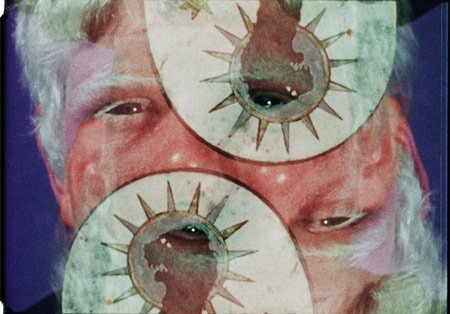Beatles Electronique
Jud Yalkut and Name June Paik
Music: "Four Loops" by Ken Werner
Also playing at Heavy Visuals '69 by the same artists: "Electronic Moon no. 2"
The Heavy Visuals '69 program includes two very short films from the PAIKPIECES series: Electronic Moon no. 2 (guest-starring Charlotte Mormon's match-lit breast) and Beatles Electronique (which can be viewed at right in a very low-bitrate clip).
In Beatles Electronique, film loops of Beatles TV performance kinescope footage were videotaped, combined with other video sources, then manipulated in the control room. Additionally, Paik used electro-magnets and other techniques to distort the monitor itself. All of this was filmed by Yalkut, and edited into this short film. The soundtrack, "Four Loops" by Ken Werner, was made using four electronically altered loops of Beatles sound recordings.
During 1968-1969, Jud Yalkut filmed and reinterpreted Paik's constant experimenting in a rapidly-made series of very short films. In 1969, Yalkut combined these into a 45 minute collection titled PAIKPIECES.
"One of the most influential filmmakers making experimental cinema in New York in the 1960s was Jud Yalkut... Since then, Yalkut has gone on to consolidate an enviable reputation as one of the most important metamedia artists in American independent cinema." (Wheeler Winston Dixon, The Exploding Eye, 1997)
Nam June Paik is widely considered to be the first video artist, beginning his experiments in 1963 while living in Germany. He was a close friend and collaborator with John Cage, deeply involved in the Fluxus art movement, and a celebrated prankster. Through various means and grants, he was able to work at WGBH in Boston and WNET in NYC, at MIT's labs, and with other engineers he met along the way.
In these filmed works and improvisations by Paik, he was experimenting with new ways of manipulating the video signal itself. In 1970, this work led to Paik and Shuya Abe building the first video synthesizer, piecing it together from cannibalized gear from disparate systems. This led directly to a series of landmark, brilliant, and often hilariously bizarre works of video art. Incredibly, a number were nationally broadcast on PBS.
The video synthesizer and all of Paik's work with video imaging has had lasting impact, down to the CGI effects of today.
